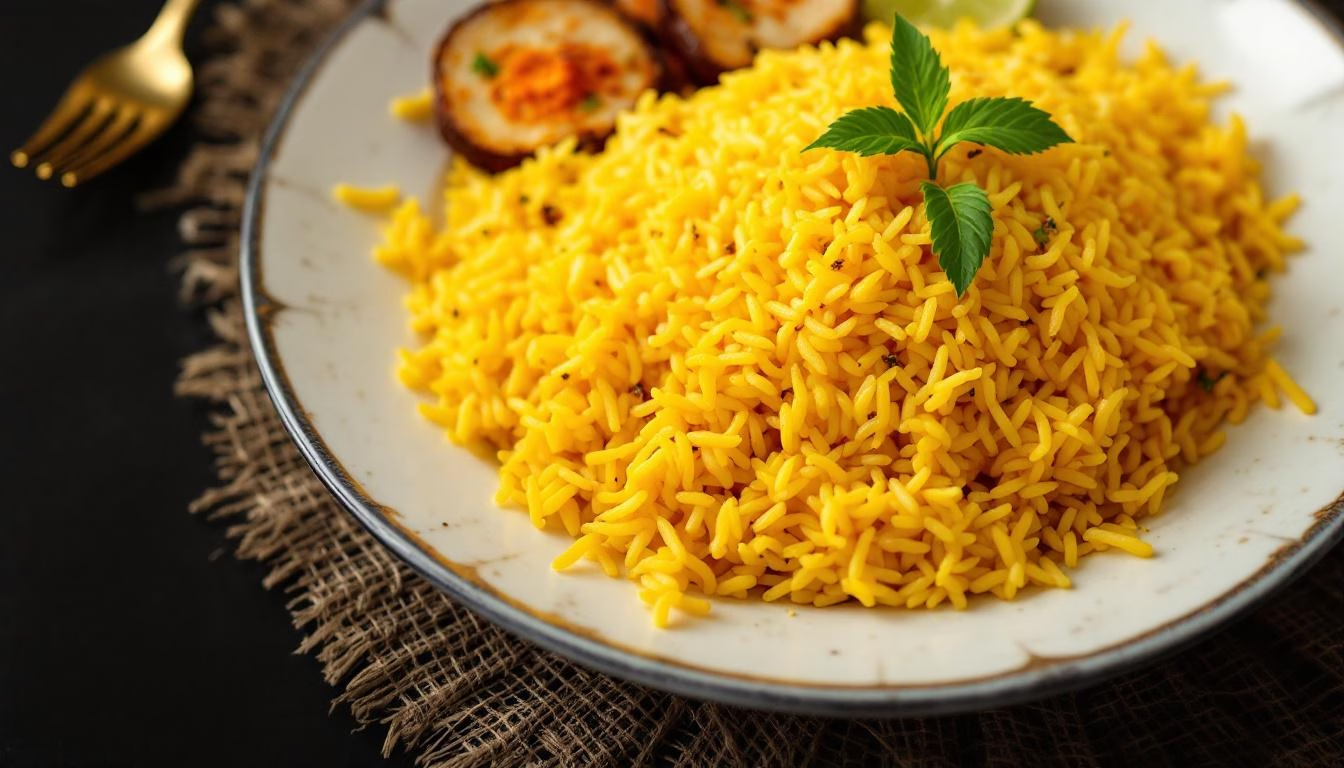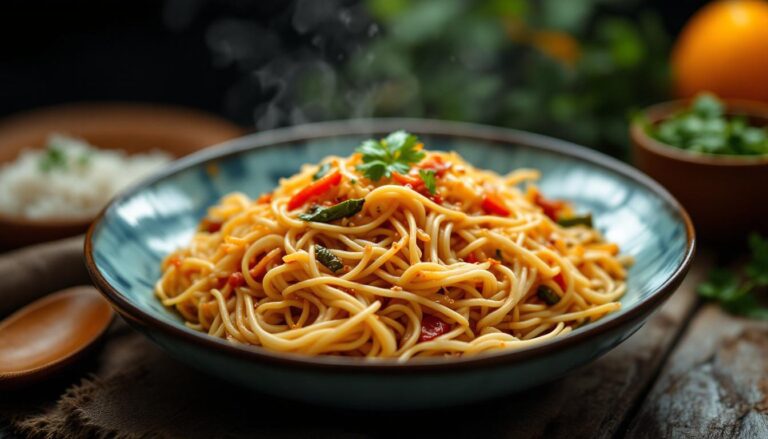Nasi Kunyit Recipe: Indonesian Golden Rice
Nasi Kunyit (Indonesian Yellow Rice Recipe): Golden Perfection in Your Steamer – Last month, I found myself staring at a bag of glutinous rice I’d bought with the best intentions—you know how it goes.

Nasi Kunyit (Indonesian Yellow Rice Recipe)
Ingredients
- 2 cups glutinous rice
- 2 teaspoons turmeric powder or 1 tablespoon freshly grated turmeric
- 1 tablespoon lime juice
- 1 lime (sliced)
- 1 teaspoon salt
- ¼ teaspoon white pepper
- 3 pandan leaves
- 2 makrut lime leaves (optional)
- 2 Indonesian bay leaves (or regular bay leaves)
- ⅔ cup coconut milk
Instructions
- Rinse glutinous rice under cold water until the water runs clear.
- Place the rice in a container, then stir in enough water to cover, turmeric, lime juice, lime, and salt. Soak the rice for at least 4 hours or overnight.
- Remove the lime slices, then drain the rice in a wire-mesh strainer.
- Move the yellow rice to a shallow plate or cake pan if your steamer is large enough to fit it. Add pandan leaves, market lime leaves, white pepper, and bay leaf.
- Steam over medium heat for 35 minutes.
- Drizzle coconut milk over the surface of the rice and steam for 5 more minutes.
- Discard pandan, bay leaf, and makrut lime leaves, then fluff the rice with a fork before serving.
Nutrition
It was tucked behind the quinoa and wild rice, looking slightly accusatory every time I opened the pantry.
I’d purchased it for some ambitious dumpling project that never materialized, and there it sat, a monument to my overenthusiastic grocery shopping.
Then my Indonesian friend Sari mentioned making nasi kunyit for her daughter’s birthday celebration, and suddenly that forgotten bag of rice transformed from pantry guilt into golden opportunity.
What followed was one of those magical cooking moments that remind you why you fell in love with food in the first place.
As the rice steamed away in my bamboo steamer, my entire kitchen filled with the most incredible aroma—earthy turmeric, floral pandan, and that unmistakable coconut richness that makes everything better.
My husband wandered in from his office three times asking what smelled so amazing, and honestly, I was pretty smug about the whole thing.
Here I was, creating something that looked like sunshine and tasted like a warm hug, all from ingredients I either had on hand or could easily find at my local Asian market.
The best part?
This Nasi Kunyit (Indonesian Yellow Rice Recipe) is embarrassingly simple.
No fancy equipment required beyond a steamer (and if you don’t have one, I’ll tell you how to improvise).
No complicated techniques that require years of practice.
Just rice, some aromatics, and a little patience while the steam works its magic.
Golden Indonesian Rice: Easy Nasi Kunyit Recipe
Nasi kunyit, which literally translates to “turmeric rice,” is Indonesia’s answer to celebratory rice dishes.
Think of it as the gorgeous, golden cousin of regular steamed rice—but with so much more personality.
This isn’t just rice that happens to be yellow; it’s rice that’s been transformed into something special through the magic of turmeric, pandan leaves, and coconut milk.
Traditionally served at special occasions like birthdays, religious ceremonies, and family gatherings, nasi kunyit represents prosperity and good fortune.
The golden color symbolizes wealth and happiness, which explains why it’s such a popular choice for celebrations.
But here’s the thing—you don’t need a special occasion to make this Nasi Kunyit (Indonesian Yellow Rice Recipe).
Sometimes Tuesday night needs a little golden magic too.
Why Glutinous Rice Makes All the Difference
The secret to authentic nasi kunyit lies in using glutinous rice (also called sticky rice or sweet rice).
Don’t let the name fool you—there’s no gluten involved here.
The “glutinous” refers to the rice’s naturally sticky, chewy texture when cooked.
This particular variety absorbs flavors beautifully and creates that satisfying, slightly dense bite that makes nasi kunyit so distinctive.
Regular jasmine or basmati rice simply won’t give you the same results.
I learned this the hard way during my first attempt, when I stubbornly used what I had on hand.
The result was perfectly fine yellow rice, but it lacked that characteristic chewiness and richness that makes nasi kunyit special.
The Complete Nasi Kunyit Recipe
This recipe serves 6 people generously, though I’ve been known to polish off embarrassing amounts of it straight from the steamer.
The total time includes soaking, which you can do overnight, making this perfect for meal prep or when you want to impress guests without last-minute stress.
Ingredients For This Nasi Kunyit Recipe You’ll Need
Indonesian yellow rice recipe (nasi kunyit guide):
For the Rice:
- 2 cups glutinous rice
- 2 teaspoons turmeric powder (or 1 tablespoon freshly grated turmeric)
- 1 tablespoon lime juice
- 1 lime, sliced
- 1 teaspoon salt
- ¼ teaspoon white pepper
For the Aromatics:
- 3 pandan leaves
- 2 makrut lime leaves (optional but recommended)
- 2 Indonesian bay leaves (regular bay leaves work too)
- ⅔ cup coconut milk
Step-by-Step Instructions
Making this Nasi Kunyit (Indonesian Yellow Rice Recipe) is a meditation in patience and anticipation.
The process itself is quite simple, but each step builds layers of flavor that create something truly special.
Preparing the Rice
How to make nasi kunyit: indonesian golden rice:
Step 1: Rinse and Clean
Start by rinsing your glutinous rice under cold water until the water runs clear.
This removes excess starch and prevents the rice from becoming gummy.
I usually do this in a fine-mesh strainer, swishing the rice around with my hands until the water stops looking cloudy.
Step 2: The Golden Soak
This is where the magic begins.
Place your rinsed rice in a large bowl and add enough water to cover by about an inch.
Stir in the turmeric powder, lime juice, lime slices, and salt.
The mixture will look like liquid sunshine—absolutely gorgeous and incredibly promising.
The soaking time is crucial here.
Plan for at least 4 hours, though overnight is even better.
This gives the turmeric time to penetrate each grain of rice, ensuring even color and flavor throughout.
I usually start this the night before I plan to serve it, which also means less work on cooking day.
Setting Up for Steaming
Step 3: Drain and Prepare
After soaking, remove those lime slices (they’ve done their job) and drain the rice thoroughly in a wire-mesh strainer.
The rice should be a beautiful golden color by now, and you might notice it’s slightly swollen from absorbing all that flavored liquid.
Step 4: Arrange for SteamingTransfer the drained rice to a shallow, heatproof plate or cake pan that fits in your steamer.
If you’re using a bamboo steamer like I do, make sure there’s enough clearance for steam to circulate.
Nestle the pandan leaves, makrut lime leaves, white pepper, and bay leaves right into the rice.
These aromatics will infuse the rice with incredible fragrance as it steams.
The Steaming Process
Step 5: First Steam
Steam the rice over medium heat for 35 minutes.
This is the perfect time to prep other parts of your meal, clean up, or just enjoy the amazing smells wafting from your kitchen.
The rice should look set but not quite done at this point.
Step 6: Coconut Milk Finish
Here comes my favorite part—drizzle that coconut milk evenly over the surface of the rice and steam for 5 more minutes.
This final addition creates incredible richness and helps bind everything together.
Watch as the coconut milk gets absorbed, creating little pockets of creamy goodness throughout.
Step 7: Final Touches
Remove from heat and discard all the aromatic leaves.
Fluff the rice gently with a fork, being careful not to mash it.
The result should be gorgeously golden, fragrant rice with a slightly chewy texture that’s absolutely irresistible.
Essential Tips for Perfect Nasi Kunyit
After making this Nasi Kunyit (Indonesian Yellow Rice Recipe) more times than I can count, I’ve learned a few tricks that make the difference between good and absolutely spectacular results.
Turmeric Tips and Tricks
If you can find fresh turmeric, absolutely use it—the flavor is more complex and the color more vibrant.
Just be warned: fresh turmeric stains everything it touches, including your hands, cutting board, and anything else in a three-foot radius.
I learned to wear gloves the hard way, after walking around with yellow-stained fingertips for a week.
Powdered turmeric works beautifully too and is much more convenient.
Look for high-quality turmeric that’s bright orange-yellow rather than dull brown—this indicates freshness and will give you better color.
Steamer Substitutions
Don’t have a proper steamer?
No problem!
You can create a makeshift steamer using a large pot with a tight-fitting lid and a heatproof bowl or plate that fits inside.
Just place a steamer basket, colander, or even an inverted heatproof bowl in the bottom of the pot, add water (making sure it doesn’t touch your rice plate), and place your rice on top.
Pandan Leaf Alternatives
Pandan leaves are the secret weapon in this recipe, adding a subtle vanilla-like fragrance that’s absolutely divine.
You can find them fresh or frozen at most Asian markets.
If you absolutely can’t locate pandan leaves, you can substitute with a tiny amount of vanilla extract (maybe ¼ teaspoon), though the flavor won’t be quite the same.
Coconut Milk Choices
Use full-fat canned coconut milk for the richest results.
Light coconut milk will work, but you’ll sacrifice some of that luxurious mouthfeel that makes this dish special.
Give the can a good shake before opening, as the cream and liquid often separate.
Creative Variations to Try
Once you’ve mastered the basic Nasi Kunyit (Indonesian Yellow Rice Recipe), there are several delicious variations worth exploring.
Each brings its own personality to this golden foundation.
Coconut Milk Variations
For an even richer version, replace some of the soaking water with coconut milk.
This creates an incredibly creamy, almost pudding-like texture that’s absolutely decadent.
I sometimes do this for special occasions when I want to pull out all the stops.
Spice Additions
A small piece of cinnamon stick or a few cardamom pods added during steaming creates warming, aromatic notes that complement the turmeric beautifully.
Star anise is another lovely addition, though use it sparingly—one pod is plenty for the entire batch.
Sweet Variations
Some regions prepare nasi kunyit as a sweet dish by adding palm sugar or regular sugar to the soaking liquid.
This version is often served as dessert with fresh fruit or coconut flakes.
If you’re curious about this variation, start with 2-3 tablespoons of sugar and adjust to taste.
Modern Twists
I’ve experimented with adding finely diced lemongrass to the rice before steaming, which creates bright, citrusy notes that pair beautifully with the earthy turmeric.
Grated ginger is another wonderful addition for those who enjoy a bit of warmth and spice.
What to Expect and How to Serve
Your finished Nasi Kunyit (Indonesian Yellow Rice Recipe) should be a gorgeous golden color with individual grains that hold together nicely without being mushy.
The texture is slightly chewy and satisfying, with a subtle coconut richness and the warm, earthy flavor of turmeric throughout.
The aroma is absolutely intoxicating—floral from the pandan, citrusy from the lime leaves, and comforting from the coconut.
This rice is incredibly versatile and pairs beautifully with both simple and complex dishes.
I love serving it alongside grilled chicken or fish, spicy curries, or even just with some sautéed vegetables and a fried egg on top.
It’s substantial enough to be satisfying on its own, but also plays well with bold flavors.
Don’t be discouraged if your first attempt isn’t picture-perfect.
Like most traditional recipes, this one improves with practice.
You’ll start to develop a feel for the right amount of liquid, the perfect steaming time, and how to adjust the seasonings to your taste.
Each time you make it, you’ll discover something new about the process and probably fall a little more in love with this golden treasure.
The best part about mastering this recipe is how it opens doors to understanding Indonesian cooking more broadly.
Once you’re comfortable with the steaming technique and flavor combinations, you’ll find yourself more confident tackling other traditional dishes.
And trust me, once word gets out that you can make restaurant-quality nasi kunyit at home, you’ll become everyone’s favorite dinner party guest.








